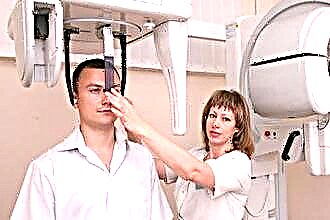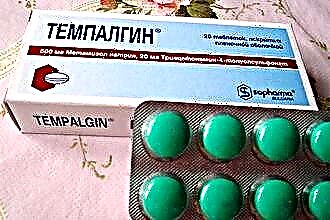Sinusitis is one of the varieties of sinusitis, in which the inflammatory process is localized in the maxillary sinuses of the nose. One or both air cavities can be affected. The pathological process develops in the front of the skull, in the initial section of the respiratory system, in the immediate vicinity of the brain, organs of vision and hearing. Therefore, one of the most characteristic symptoms is sinus pain.
The reasons for the development of the syndrome
 At the initial stage of the disease, unpleasant sensations are caused by inflammatory processes in the nose, as a result of which tissue edema is noted, the mucous membrane swells and prevents the natural outflow of fluid. The developing stagnation leads to the accumulation of exudate in the sinus, which presses with increasing force on the walls of the accessory pocket and is perceived as pain in sinusitis. This increases intracranial and intraocular pressure.
At the initial stage of the disease, unpleasant sensations are caused by inflammatory processes in the nose, as a result of which tissue edema is noted, the mucous membrane swells and prevents the natural outflow of fluid. The developing stagnation leads to the accumulation of exudate in the sinus, which presses with increasing force on the walls of the accessory pocket and is perceived as pain in sinusitis. This increases intracranial and intraocular pressure.
The nature of the sensations in this case is pronounced pressure in the front of the face in the projection of the affected sinuses and forehead.
These sensations are similar to migraines and vasomotor rhinitis, since they come with strong attacks that bring real torment to a person.
Unlike migraine, which is aggravated by external influences (light and noise), and vasomotor rhinitis, which is concentrated in the temporal, occipital and parietal parts of the skull, sinus pain is activated when bending and turning the head. Swelling under the eyes is also noticeable, the skin in these areas becomes soft.
Depending on the duration of the development of the disease and the specific features of the syndrome, three stages of pain are distinguished:
- First stage. The nose is stuffy, the pain is not felt, it is blurred, in the morning it is felt in the occipital part, and during the day it moves to the frontal segment and disappears after a few hours.
- The disease continues to progress, spasms become more intense, first localized in the area of the cheekbones, eyes and nose, then spread to the entire head and teeth.
- The syndrome begins to be paroxysmal. Seizures can occur when leaving a warm room to fresh air or any changes in ambient temperature.
The stronger the swelling of the tissues, the more fluid accumulates in the cavities. Disease-causing bacteria actively multiply and increase the general intoxication of the body. The mucus becomes dense and cannot escape through the narrowed anastomosis. It presses on the walls of the sinus, causing severe pain, often accompanied by dizziness, nausea, vomiting, hyperthermia, which must be removed as quickly as possible.
What organs can hurt with sinusitis
 Pain in sinusitis can alternately cover different parts of the head, change its characteristics. Unpleasant sensations may occur in such organs:
Pain in sinusitis can alternately cover different parts of the head, change its characteristics. Unpleasant sensations may occur in such organs:
- Head. At first, slight sensations of a diffuse character appear in the back of the head or without a clear dislocation, intensifying in the morning and somewhat weakening during the day. Later, they move into the area of the affected accessory chamber, begin to bear a bursting character. The pain becomes severe and throbbing on palpation and bending forward due to excessive pressure.
- Teeth. Separated from the sinus only by a thin septum, the oral cavity is one of the first to take the hit of the disease. Through the roots of the upper teeth located nearby or protruding into the maxillary sinuses, pain covers them, which often prompts a person to go to the dentist, and not to the otolaryngologist.
- Eyes. The orbit is located adjacent to the maxillary sinus, the dividing wall between them is pierced by a large number of nerves, which, if infected with pathogens, lead to conjunctivitis and other complications.
- Forehead. The sensitivity of the areas above the inner part of the eyebrows may indicate that the inflammatory process has spread to the frontal accessory pockets, causing frontal sinusitis or, even worse, pansinusitis, when all the airways are affected.
- Ears. Acute lumbago in the ears and hearing impairment are the result of the ingress of microorganisms into the middle ear through the Eustachian tube, which serves to drain and equalize the atmospheric pressure between the tympanic cavity and the external environment.
- Throat. Soreness arises from the fact that with the air flow, pathogens are carried through the respiratory tract, irritating the walls of the throat and trachea and causing coughing and sneezing. Pharyngitis often develops.
A very severe pain syndrome may indicate that serious complications have occurred, such as otitis media, pneumonia, sepsis, or meningitis.
Diagnosis of disease symptoms
In order to differentiate the patient's sensations with inflammation of the maxillary pockets from similar signs of other diseases, the doctor carries out diagnostics based on the following methods:
- Conversation with the patient, identification of previous sensations and the place of localization of the syndrome at different times of the day and with different external stimuli.

- Visual examination of the nasal cavity in order to identify redness, tightness and swelling of the tissues characteristic of sinusitis.
- Palpation (feeling) of the face in the projection of the sinuses and wings of the nose.
- General blood analysis.
- X-ray or computed tomography.
- Analysis of a smear from the nasal mucosa.
- Allergotest if necessary in the presence of prior allergic rhinitis.
Ways to get rid of pain
Sinusitis is a serious disease with complex clinical symptoms. Therefore, it is necessary to relieve pain syndrome in parallel with the suppression of pathogens and other signs. Complete therapy is divided into two main parts: etiological and symptomatic.
Etiological therapy is a sanitation aimed at eliminating the cause of the disease, in our case, inflammation of the maxillary sinus mucosa. For this, pharmacological drugs used orally or parenterally are used:
- Antibiotics of a number of penicillins (Flemoxin solutab, Amoxiclav), macrolides (Macropen) or cephalosporins (Ceftriaxone, Cefazolin). The latter are injected or used when flushing air pockets.
- Mucolytics to liquefy and facilitate the evacuation of accumulated secretions (Mukaltin, Ambrobene, Flavamed).
- Decongestants and antihistamines in the form of drops and sprays (Naphthyzin, Galazolin, Rinazolin) to restore nasal breathing and improve mucus outflow.
- Non-steroidal anti-inflammatory drugs based on ibuprofen (Nurofen), acetylsalicylic acid (Aspirin), diclofenac.
- Corticosteroids in the nose (Amavis).
Often in medical practice, surgical intervention is used - a puncture (puncture) of a thin section of the sinus wall through the nasal passage for the forced removal of purulent exudate.
 In fact, a temporary fistula is created, through which pus is drained away, while the intracranial pressure is noticeably reduced, and the pain syndrome decreases sharply. Common indications for a puncture are:
In fact, a temporary fistula is created, through which pus is drained away, while the intracranial pressure is noticeably reduced, and the pain syndrome decreases sharply. Common indications for a puncture are:
- Strengthening of spasms and their spread to various parts of the head.
- The ineffectiveness of conservative treatment or the impossibility of its full implementation due to the presence of contraindications to drugs (chronic diseases, pregnancy).
- The development of an abscess (purulent process) near the eyeball, threatening visual impairment and blindness.
- The presence of congestion in the cavity, confirmed by X-ray data. In this case, the picture shows a horizontal level of mucus with pus.
Repeated washing of the nasal cavity and accessory pockets can somewhat alleviate the patient's condition. To do this, use:
- Sea and table salt, as well as sea water. The solution should not be very saturated so as not to burn the mucous membrane. Half a teaspoon of salt in a glass of warm water is sufficient.
- Physiological solutions. For a greater antimicrobial effect, a pair of potassium permanganate crystals (to a faint pink color), 2-3 drops of iodine or half a teaspoon of soda are added to the saline solution.
- Pharmacy solutions prepared on the basis of sea water (Dolphin, Aqua Maris, Aqualor).
For proper washing, it is necessary to clear the nasal passages or drip a vasoconstrictor drug (with severe congestion), after a few minutes, bend over the sink, slightly turning your head to one side. With a special teapot, a syringe without a needle or a mini-syringe, the liquid is fed into the nasal cavity. It should flow into the upper nostril and out through the lower one. Do not create high pressure to avoid leakage of infected fluid down the throat or into the Eustachian tube. After the end of the procedure, you need to stand with your head bowed so that all the water flows out of the chambers, and then blow your nose thoroughly.
The above method is convenient to use at home. In a hospital setting, other washing methods are used using:
- Sinus catheter YAMIK, working on the principle of creating a vacuum in the nasal cavity. Convenient in that it can be used for children aged 5 and over.
- Aspirator-suction ("cuckoo"). To improve the circulation of the solution, an aspirator creates a reduced pressure in one of the sinuses.
Symptomatic therapy is to relieve pain as quickly and effectively as possible. For this, pain relievers are used in the following forms:
 Tablets. Mild or moderate spasms can be eliminated with common and relatively inexpensive drugs, such as Analgin, Aspirin, Paracetamol, Tempalgin, Spazmalgon. They have a good anti-inflammatory effect and also relieve fever. Severe attacks require drugs with a large analgesic effect (Ketalong, Ketanov), which relieve the symptom for 8-12 hours. You need to take them once or systemically for no more than 5 days. However, such powerful drugs are contraindicated in pregnant women, children under the age of 16 and those prone to bleeding.
Tablets. Mild or moderate spasms can be eliminated with common and relatively inexpensive drugs, such as Analgin, Aspirin, Paracetamol, Tempalgin, Spazmalgon. They have a good anti-inflammatory effect and also relieve fever. Severe attacks require drugs with a large analgesic effect (Ketalong, Ketanov), which relieve the symptom for 8-12 hours. You need to take them once or systemically for no more than 5 days. However, such powerful drugs are contraindicated in pregnant women, children under the age of 16 and those prone to bleeding.- Gargling or dusting solutions (for toothache). The powder can be made using a powder or by crushing a tablet, apply to the gums and rub lightly with your finger. The same drugs can be diluted in water and rinsed in the mouth for several minutes until the discomfort subsides.
- Liniments and ointments with adrenergic blockers to reduce inflammation in the eyes (tetracycline and erythromycin ointment, Ofloxacin, Hydrocortisone).
Alternative methods are often used in practice:
- Acupressure massage aimed at enhancing metabolism and increasing the flow of arterial blood to the affected areas.
- Rinsing the mouth with infusions from natural products (propolis, lemon balm extract, tincture of garlic, mint or sage).
The impact of these methods is not so noticeable, but they do not have side effects and are suitable for people who have contraindications to pharmacological drugs.


 Tablets. Mild or moderate spasms can be eliminated with common and relatively inexpensive drugs, such as Analgin, Aspirin, Paracetamol, Tempalgin, Spazmalgon. They have a good anti-inflammatory effect and also relieve fever. Severe attacks require drugs with a large analgesic effect (Ketalong, Ketanov), which relieve the symptom for 8-12 hours. You need to take them once or systemically for no more than 5 days. However, such powerful drugs are contraindicated in pregnant women, children under the age of 16 and those prone to bleeding.
Tablets. Mild or moderate spasms can be eliminated with common and relatively inexpensive drugs, such as Analgin, Aspirin, Paracetamol, Tempalgin, Spazmalgon. They have a good anti-inflammatory effect and also relieve fever. Severe attacks require drugs with a large analgesic effect (Ketalong, Ketanov), which relieve the symptom for 8-12 hours. You need to take them once or systemically for no more than 5 days. However, such powerful drugs are contraindicated in pregnant women, children under the age of 16 and those prone to bleeding.

